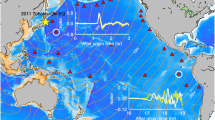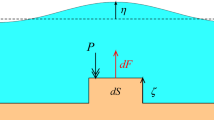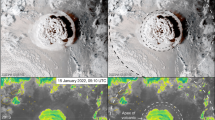Abstract
Three major Kuril Islands earthquakes (Mw = 8.3 on 4 October 1994, Mw = 8.3 on 15 November 2006 and Mw = 8.1 on 13 January 2007) generated trans-oceanic tsunamis that were recorded over the entire Pacific Ocean. The tsunami sources had significantly different geometries, which led to different impacts in the near-field and far-field zones. We used numerical models to investigate the source efficiency and resulting wave directivity of the three tsunamis. The tsunami models were validated and calibrated using field survey data from the Central Kuril Islands and deep-ocean bottom pressure records in the North Pacific. Using the full energy flux distribution, we conclude that the source of the 2007 event had the most well-defined energy flux directivity and that the tsunami energy radiation from the 1994 event was the most isotropic. Radiation patterns of each source clearly show the fraction of wave energy radiated into the open ocean, as well as that which penetrated into the Sea of Okhotsk through the Kuril Straits or was captured by the shelf and spread from the source area along the Kuril Ridge. We find a noticeable increase in the period of the leading wave emitted from the end of the elongated tsunami sources compared to the period of the waves formed in the transverse direction. The onshore-directed energy flux is shown to be a key factor controlling tsunami amplitudes at the coast.









Similar content being viewed by others
References
Baba, T., Cummins, P. R., Thio, H. K., & Tsushima, H. (2009). Validation and joint inversion of teleseismic waveforms for earthquake source models using deep ocean bottom pressure records: A case study of the 2006 Kuril megathrust earthquake. Pure and Applied Geophysics, 166(1–2), 55–76. https://doi.org/10.1007/s00024-008-0438-1
Baranov, B. V., Ivashchenko, A. I., & Dozorova, K. A. (2015). The Great 2006 and 2007 Kuril earthquakes, forearc segmentation and seismic activity of the Central Kuril Islands region. Pure and Applied Geophysics, 172(12), 3509–3535. https://doi.org/10.1007/s00024-015-1120-z
Ben-Menahem, A., & Rosenman, M. (1972). Amplitude patterns of tsunami waves from submarine earthquakes. Journal of Geophysical Research, 77(17), 3097–3128.
Dengler, L., Uslu, B., Barberopoulou, A., et al. (2009). The November 15, 2006 Kuril Islands-generated tsunami in Crescent City, California. Pure and Applied Geophysics, 166, 37–53.
Fine, I. V., Kulikov, E. A., & Cherniawsky, J. Y. (2013). Japan’s 2011 tsunami: Characteristics of wave propagation from observations and numerical modelling. Pure and Applied Geophysics, 170, 1295–1307. https://doi.org/10.1007/s00024-012-0555-8
Fine, I. V., Thomson, R. E., Chadwick, W. W., Jr., & Fox, C. G. (2020). Toward a universal frequency of occurrence distribution for tsunamis: Statistical analysis of a 32-year bottom pressure record at axial seamount. Geophysical Research Letters, 47(10), 1–9. https://doi.org/10.1029/2020GL087372
Finite fault model for 10/4/1994 earthquake with Mw = 8.3. https://earthquake.usgs.gov/earthquakes/eventpage/usp0006kdp/finite-fault. Accessed Nov 2020.
Fujii, Y., & Satake, K. (2008). Tsunami sources of the November 2006 and January 2007 great Kuril earthquakes. Bulletin of the Seismological Society of America, 98(3), 1559–1571. https://doi.org/10.1785/0120070221
Fukao, Y., & Furumoto, M. (1975). Foreshocks and multiple shocks of large earthquakes. Physics of the Earth and Planetary Interiors, 10(4), 355–368.
Gill, A. E. (1982). Atmosphere-ocean dynamics (p. 662). Academic Press.
Gusiakov, V. K. (2014). Strongest tsunamis in the World Ocean and the problem of marine coastal security. Izvestiya, Atmospheric and Oceanic Physics, 50(5), 435–444. https://doi.org/10.1134/S0001433814050041
Hébert, H., Heinrich, P., Schindelé, F., & Piatanesi, A. (2001). Far-field simulation of tsunami propagation in the Pacific Ocean: Impact on the Marquesas Islands (French Polynesia). Journal of Geophysical Research: Oceans, 106(C5), 9161–9177.
Horrillo, J., Knight, W., & Kowalik, Z. (2008). Kuril Islands tsunami of November 2006: 2. Impact at Crescent City by local enhancement. Journal of Geophysical Research: Oceans, 113(C1), 1–12. https://doi.org/10.1029/2007JC004404
Ivanova, A. A., Kulikov, E. A., & Fain, I. V. (2017). On modelling 2006, 2007 Simushir tsunamis in the central Kuril region. Fundamental and Applied Geophysics, 10(3), 56–64. In Russian.
Ji, C., Wald, D. J., & Helmberger, D. V. (2002). Source description of the 1999 Hector Mine, California, earthquake, part I: Wavelet domain inversion theory and resolution analysis. Bulletin of the Seismological Society of America, 92(4), 1192–1207.
Kajiura, K. (1970). Tsunami source, energy and the directivity of wave radiation. Bulletin of the Earthquake Research Institute, the University of Tokyo, 48, 835–869.
Kajiura, K. (1972). The directivity of energy radiation of the tsunami generated in the vicinity of a continental shelf. Journal of Oceanography, 28(6), 260–277.
Kajiura, K. (1981). Tsunami energy in relation to parameters of the earthquake fault. Bulletin of the Earthquake Research Institute, 56, 415–440.
Kânoğlu, U., Titov, V., Bernard, E., & Synolakis, C. (2015). Tsunamis: Bridging science, engineering and society. Philosophical Transactions of the Royal Society a: Mathematical, Physical and Engineering Sciences, 373(2053), 20140369. https://doi.org/10.1098/rsta.2014.0369
Katsumata, K. (2017). Long-term seismic quiescences and great earthquakes in and around the Japan subduction zone between 1975 and 2012. Pure and Applied Geophysics, 174, 2427–2442. https://doi.org/10.1007/s00024-016-1415-8
Kerr, R. A. (2005). Model shows islands muted tsunami after latest Indonesian quake. Science, 308(5720), 341–342.
Koshimura, S., Hayashi, Y., Munemoto, K., & Imamura, F. (2008). Effect of the Emperor seamounts on trans-oceanic propagation of the 2006 Kuril Island earthquake tsunami. Geophysical Research Letters, 35(2), 1–6. https://doi.org/10.1029/2007GL032129
Kowalik, Z., Knight, W., Logan, T., & Whitmore, P. (2007). The tsunami of 26 December, 2004: Numerical modelling and energy considerations. Pure and Applied Geophysics, 164(2–3), 379–393. https://doi.org/10.1007/s00024-006-0162-7
Kowalik, Z., Horrillo, J., Knight, W., & Logan, T. (2008). Kuril Islands tsunami of November 2006: 1. Impact at Crescent City by distant scattering. Journal of Geophysical Research: Oceans, 113(C1), 1–11. https://doi.org/10.1029/2007JC004402
Kulikov, E. A., Fine, I. V., & Yakovenko, O. I. (2014). Numerical modeling of the long surface waves scattering for the 2011 Japan tsunami: Case study. Izvestiya, Atmospheric and Oceanic Physics, 50(5), 498–507. https://doi.org/10.1134/S0001433814050053
Laverov, N. P., Lobkovsky, L. I., Levin, B. W., et al. (2009). The Kuril tsunamis of November 15, 2006, and January 13, 2007: Two trans-Pacific events. Doklady Earth Sciences, 426(1), 658–664. https://doi.org/10.1134/S1028334X09040333
Levin, B. W., Kaistrenko, V. M., Rybin, A. V., et al. (2008). Manifestations of the tsunami on November 15, 2006, on the Central Kuril Islands and results of the runup heights modelling. Doklady Earth Sciences, 419(1), 335–338. https://doi.org/10.1134/S1028334X08020335
Lobkovsky, L. I., Kulikov, E. A., Rabinovich, A. B., et al. (2008). Earthquakes and tsunamis (November 15, 2006, and January 13, 2007) in the Central Kuril Islands region: A justified prediction. Doklady Earth Sciences, 419(1), 320–324. https://doi.org/10.1134/S1028334X0802030X
Lobkovsky, L. I., Rabinovich, A. B., Kulikov, E. A., et al. (2009). The Kuril Earthquakes and tsunamis of November 15, 2006, and January 13, 2007: Observations, analysis, and numerical modelling. Oceanology, 49(2), 166–181. https://doi.org/10.1134/S0001437009020027
MacInnes, B. T., Pinegina, T. K., Bourgeois, J., et al. (2009). Field survey and geological effects of the 15 November 2006 Kuril tsunami in the middle Kuril Islands. Pure and Applied Geophysics, 166, 9–36. https://doi.org/10.1007/s00024-008-0428-3
Miyoshi, H. (1955). Directivity of the recent tsunamis. Journal of the Oceanographical Society of Japan, 11(4), 151–155.
Mofjeld, H. O., Titov, V. V., González, F. I., & Newman, J. C. (2001). Tsunami scattering provinces in the Pacific Ocean. Geophysical Research Letters, 28(2), 335–337.
Okada, Y. (1985). Surface deformation due to shear and tensile faults in a half-space. Bulletin of the Seismological Society of America, 75(4), 1135–1154.
Okal, E. A. (2003). Normal modes energetics for far-field tsunamis generated by dislocations and landslides. Pure and Applied Geophysics, 160, 2189–2221. https://doi.org/10.1007/s00024-003-2426-9
Rabinovich, A. B., Lobkovsky, L. I., Fine, I. V., et al. (2008). Near-source observations and modeling of the Kuril Islands tsunamis of 15 November 2006 and 13 January 2007. Advances in Geosciences, 14, 105–116.
Rabinovich, A. B., Candella, R. N., & Thomson, R. E. (2013). The open ocean energy decay of three recent trans-Pacific tsunamis. Geophysical Research Letters, 40(12), 3157–3162. https://doi.org/10.1002/grl.50625
Rabinovich, A. B., Titov, V. V., Moore, C. W., & Eblé, M. C. (2017). The 2004 Sumatra tsunami in the southeastern Pacific Ocean: New global insight from observations and modeling. Journal of Geophysical Research: Oceans, 122(10), 7992–8019. https://doi.org/10.1002/2017JC013078
Saloor, N., & Okal, E. A. (2018). Extension of the energy-to-moment parameter Θ to intermediate and deep earthquakes. Physics of the Earth and Planetary Interiors, 274, 37–48.
Satake, K. (1988). Effects of bathymetry on tsunami propagation: Application of ray tracing to tsunamis. Pure and Applied Geophysics, 126(1), 27–36.
Satake, K., & Tanioka, Y. (1999). Sources of tsunami and tsunamigenic earthquakes in subduction zones. Pure and Applied Geophysics, 154(3–4), 467–483.
Shevchenko, G. V., Loskutov, A. V., & Kaistrenko, V. M. (2018). A new map of tsunami hazard for the South Kuril Islands. Geosystems of Transition Zones, 2(3), 225–238.
Stephenson, F. E., & Rabinovich, A. B. (2009). Tsunamis on the Pacific coast of Canada recorded in 1994–2007. Pure and Applied Geophysics, 166(1–2), 177–210. https://doi.org/10.1007/s00024-008-0440-7
Tang, L., Titov, V. V., Bernard, E. N., et al. (2012). Direct energy estimation of the 2011 Japan tsunami using deep-ocean pressure measurements. Journal of Geophysical Research: Oceans, 117, C08008. https://doi.org/10.1029/2011JC007635
Tanioka, Y., Ruff, L., & Satake, K. (1995). The great Kurile earthquake of October 4, 1994 tore the slab. Geophysical Research Letters, 22(13), 1661–1664.
Tanioka, Y., Hasegawa, Y., & Kuwayama, T. (2008). Tsunami waveform analyses of the 2006 underthrust and 2007 outer-rise Kurile earthquakes. Advances in Geosciences, 14, 129–134.
Titov, V. V., & Synolakis, C. E. (1997). Extreme inundation flows during the Hokkaido-Nansei-Oki tsunami. Geophysical Research Letters, 24(11), 1315–1318.
Titov, V. V., Rabinovich, A. B., Mofjeld, H. O., Thomson, R. E., & Gonzalez, F. J. (2005). The global reach of the 26 December 2004 Sumatra tsunami. Science, 309, 2045–2048.
Titov, V., Song, Y. T., Tang, L., Bernard, E. N., Bar-Sever, Y., & Wei, Y. (2016). Consistent estimates of tsunami energy show promise for improved early warning. Pure and Applied Geophysics, 173(12), 3863–3880. https://doi.org/10.1007/978-3-319-55480-8_11
Vladimirova, I. S., Lobkovsky, L., Gabsatarov, Y., et al. (2020). Patterns of the seismic cycle in the Kuril Island Arc from GPS observations. Pure and Applied Geophysics, 177, 3599–3617. https://doi.org/10.1007/s00024-020-02495-z
Wang, K., Thomson, R. E., Rabinovich, A. B., Fine, I. V., & Insua, T. L. (2020). The 2018 Alaska-Kodiak Tsunami off the West Coast of North America: A rare mid-plate tsunamigenic event. Pure and Applied Geophysics, 173, 1347–1378. https://doi.org/10.1007/s00024-020-02427-x
Watada, S., Kusumoto, S., & Satake, K. (2014). Traveltime delay and initial phase reversal of distant tsunamis coupled with the self-gravitating elastic Earth. Journal of Geophysical Research: Solid Earth, 119(5), 4287–4310. https://doi.org/10.1002/2013JB010841
Woods, M. T., & Okal, E. A. (1987). Effect of variable bathymetry on the amplitude of teleseismic tsunamis: A ray-tracing experiment. Geophysical Research Letters, 14, 765–768.
Yeh, H., Titov, V., Gusiakov, V., et al. (1995). The 1994 Shikotan earthquake tsunamis. Pure and Applied Geophysics, 144(3–4), 855–874.
Acknowledgements
This study work was supported by the Russian State Assignment of IORAS #0128-2021-0004. We also thank Drs. Isaac Fine and Richard Thomson for their internal reviews and editing.
Funding
This study work was supported by the Russian State Assignment of IORAS #0128-2021-0004.
Author information
Authors and Affiliations
Contributions
Not applicable.
Corresponding author
Ethics declarations
Conflicts of interest
Not applicable.
Ethics approval
Not applicable.
Availability of data and material
Open access.
Code availability
Not applicable.
Consent to participate
Not applicable.
Consent for publication
Not applicable.
Additional information
Publisher's Note
Springer Nature remains neutral with regard to jurisdictional claims in published maps and institutional affiliations.
Rights and permissions
About this article
Cite this article
Kulikov, E.A., Ivanova, A.A. Tsunami Generation Efficiency of the 1994, 2006 and 2007 Kuril Islands Earthquakes. Pure Appl. Geophys. 178, 4921–4939 (2021). https://doi.org/10.1007/s00024-021-02887-9
Received:
Revised:
Accepted:
Published:
Issue Date:
DOI: https://doi.org/10.1007/s00024-021-02887-9




